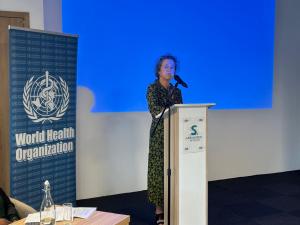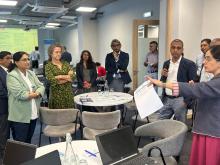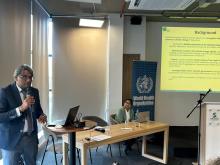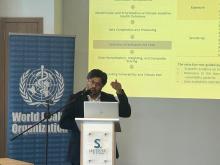Mauritius Takes Bold Steps Toward Climate-Resilient Health System with Landmark health Vulnerability Adaptation and Assessment
Mauritius marks a pivotal moment in its journey towards building a climate resilient health system faced to the growing threats against climate change with the dissemination of the comprehensive findings of the advanced draft Vulnerability and Adaptation (V&A) Assessment report - spearheaded by the Ministry of Health and Wellness with the support of the World Health Organization (WHO) and the Green Climate Fund(GCF).
“As a small island developing state, Mauritius faces unique threats from climate change—rising seas, extreme weather, and evolving disease patterns. This V&A Assessment report is crucial for understanding how climate affects health and for identifying those most at risk.” said Dr. Anne Ancia, WHO Representative, intervening during the opening of the workshop.
Mrs M. Ramkhelawon, Permanent Secretary, Ministry of Health and Wellness, emphasized the urgency of the initiative : “Climate change is not a distant threat—it is already impacting our health system. This assessment provides the evidence we need to act decisively and protect our most vulnerable citizens”.
Mauritius, despite its strong public health infrastructure and commitment to universal health coverage, remains highly exposed to climate-related threats. Cyclones and floods have led to a resurgence of vector- and water-borne diseases, threatening hard-won progress in disease control – highlighting the urgent need for adaptive and mitigating strategies.
The V&A Assessment identifies key vulnerabilities, including :
- the country’s aging population,
- high burden of non-communicable diseases,
- high reliance on imported food,
- high exposure to extreme weather events.
The assessment evaluates four core components :
- Sensitivity (Based on demographics, socio-economic factors, and pre-existing health conditions);
- Adaptive Capacity( Focused on healthcare infrastructure, workforce, and disease mitigation);
- Exposure( Analyzing climatic changes and their health implications); and
- Hazard( Assessing climate-driven health risks and disease burdens).
These components were benchmarked against WHO’s six health system building blocks:
Leadership & Governance, Health Workforce, Information Systems, Medicines & Technologies, Service Delivery, and Financing.
The V&A Assessment, aligned with WHO’s Operational Framework for Climate-Resilient, Low-Carbon Health Systems, is designed to inform policy, guide programming, and strengthen capacity to anticipate and manage health impacts of climate change—especially for high-risk groups such as children, the elderly, pregnant women, and persons living with disability.
Additionally, the report emphasizes the need for equity-driven, targeted interventions, especially for the highly vulnerable groups. It also calls for a multi-sectoral approach that integrates health, climate, and socio-economic policies.
A technical workshop enabled in-depth review of the methodology and fostered knowledge transfer to strengthen national capacity for future assessments.
The members of the technical working group deep dive into the methodology adopted to carry out the V&A assessment. The transfer of knowledge will empower the Ministry of Health and Wellness to lead future assessment.
Looking ahead, Mauritius will soon start development of an Early Warning Alert and Response System (EWARS)—a predictive tool designed to anticipate outbreaks of climate-sensitive diseases such as dengue and chikungunya 4–12 weeks in advance. Rooted in weather-disease correlations, EWARS will empower epidemiologists, entomologists, meteorologists, and emergency managers to respond rapidly and effectively.
As climate change continues to reshape health landscapes, Mauritius is emerging as a leader among small island developing states within the Indian Ocean in matters of climate-resilient health system.
With sustained political will, international partnerships, and strong financial backing, the country is poised to transform its healthcare system into a model of resilience, equity and innovation.





